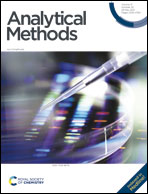Anodic near-infrared electrochemiluminescence from Cu-doped CdTe quantum dots for tetracycline detection†
Abstract
A sensitive anodic near-infrared electrochemiluminescence (ECL) immunosensor for the detection of tetracycline, based on Cu-doped CdTe quantum dots, was fabricated for the first time in this work. We have synthesized Cu-doped CdTe quantum dots by co-precipitation. The emission spectrum of the Cu-doped CdTe quantum dots could reach the near-infrared region at 730 nm in a short reflux time. More importantly, the ECL intensity of the CdTe quantum dots was enhanced by 2 fold after Cu element doping, which was attributed to the Cu d-orbital mixed with the conduction band and valence band of the host CdTe quantum dots. Inspired by the strong anodic ECL intensity of Cu-doped CdTe quantum dots, the anodic near infrared ECL sensor was constructed to detect tetracycline by competitive immunoassay. The detection range of the developed biosensor was 0.01–10 ng mL−1 and the detection limit was 0.0030 ng mL−1. In addition, the biosensor showed outstanding selectivity, long-term stability and high reproducibility, which has great potential in the field of analysis and detection.



 Please wait while we load your content...
Please wait while we load your content...